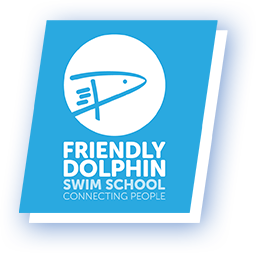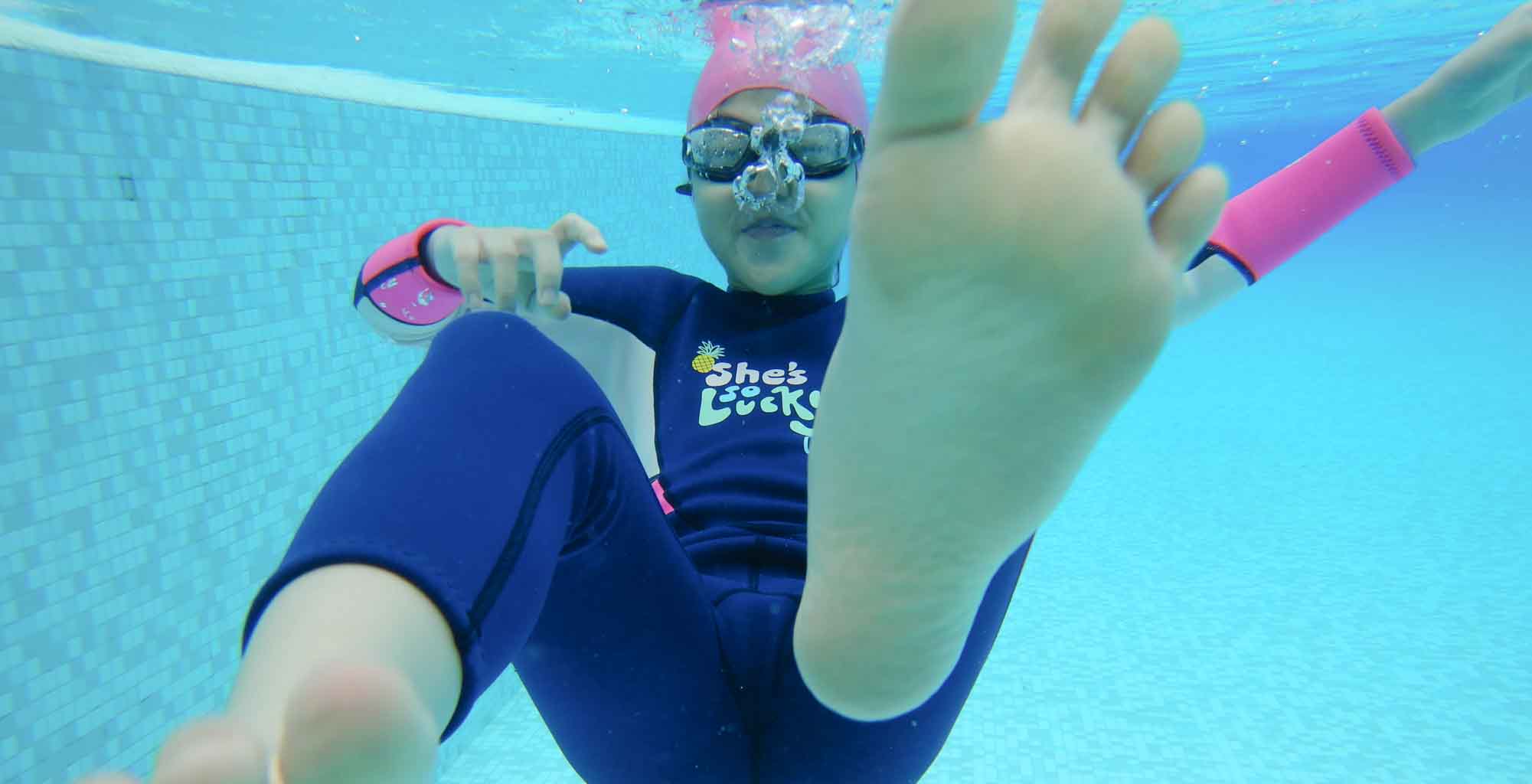BABY SWIMMING LESSONS COURSE OVERVIEW
Course Highlights
In this baby swimming lessons course, participants will learn:
- How to cuddle the baby in the swimming pool, build their water confidence, improve their kicking ability, and eventually get ready for swimming lessons.
- Balance skills in the water. Teach babies the ability to recover when they move left or right and float while lying on the parent’s body.
- Babies will be taught bobbing skills in water moving from chin level, gradually leading to no fear of submersion.
- Further develop the control of breathing skills in the water, blowing bubbles games in the swimming pool.
- Babies will learn how to move in a horizontal position in the water. Swimming in a vertical position is very inefficient and makes learning to swim more difficult.
- Submersion sensory input ignites the natural reflex of holding their breath underwater.
- Fearless jumps into the water and boosts water confidence skills.
Why Baby Swimming Lessons?
According to recent findings in the fields of neurology and human development, it is critical to begin developing physical capabilities from an early age. Physical education students who started at the beginning of the school year were shown to have a considerable advantage over those who started later on.
The following are some of the advantages of early exposure to water for babies, as demonstrated by research
- Develop self-reliance
- Coordination improvement
- Gain strength and self-confidence by swimming, which stimulates the mind and brain in new and interesting ways.
- Swimming’s constant motion is good for your child’s internal and external wellness.
Baby Swimming with Friendly Dolphin
Our swim school strives to improve student performance and learning. We’ve spent years perfecting instructional tactics to make learning more enjoyable and beneficial for students of all ages.
According to studies, schools that implemented multiple intelligences saw significant advances in newborn development and a rise in Intelligence Quotients in subsequent years.
- Many people find considerable advances in art, music, physical education, social interactions, and awareness of nature and oneself.
Baby Swimming Lessons Singapore Locations?
We conduct all our swimming classes in the private swimming pool in Singapore. Water temperatures are crucial; too high or too low might be detrimental to the baby swimming lessons.
The ideal temperatures for swimming with babies range from 32-degree Celsius to 33-degree Celsius.
We believe in putting real-time situation for babies to adopt earlier. The mild and harsh environment might be one of the best condition to enable your babies to put in the hard work first, get adapted to swimming, and help build strong foundations for their later swimming.
Key Features
Up-to-date, bite-sized swimming course modules
Hands-on, interactive, instructor-led swimming lessons.
Slow-paced lessons and students are allowed to overcome their fears
Learning swimming skills in a safe, nurturing environment.
Clear and concise verbal directions
Visual demonstrations
Hands-on teaching methods
Course Description
The objective for babies to learn in babies’ swimming lessons are water familiarization and progressive water confidence.
Specialized babies swimming lessons that incorporate love, care, frequent cuddling, hugs, and kisses for positive learning.
All concepts and programs for babies swimming classes will be organized in a sequence of activities from the easiest ones to the more complex ones.
Babies will be taught how to swim towards father and mother submerged in water, independent climbing out of the water, blowing bubbles, bobbing up and down in our structured babies swimming classes.
How to hold on to the side of the pool
Babies will learn how to push off from the side of the pool independently, gradually increasing the distance and speed at which the babies swim towards the parents.
Students and parents will be taught water safety knowledge and how to prepare for the swimming environment for the babies.
Baby Swimming Class Checklist For Newborns
Frequent cuddling, with many hugs and kisses.
Balancing and floating with the baby’s chin on the parent’s shoulder
Floating on the back
Blowing bubbles
Bobbing up and down
Passing under a gentle shower (up to 10 times non-stop)
Going underwater
Passing under a shower followed by going underwater (after the tenth pass under the shower)
Jumping into the bath or pool
Grasping the side of the tub or the parent’s thumbs
End the sessions with lots of hugs and kisses.
Baby Swimming Class Checklist For Six to Twelve Months Old
Frequent cuddling with hugs and kisses
Floating on the back
Swimming to parent
Swimming between mother and father
Jumping into water from the side of the pool
Climbing out of the pool
Blowing bubbles
Baby Swimming Class Checklist For One to Two Years Old
Frequent cuddling with hugs and kisses from parents
Bobbing up and down into the pool
Holding the side of the pool
Swimming to the steps
Floating on the back
Swimming from the steps to parent
Jumping and diving from a sitting position to parent. Progress to diving from a kneeling position, then from a standing position.
Pushing off and swimming to parent
Swimming to parent, take a breath, submerge, and continue to swim.
Climbing out of the pool, including using the ladder.
Course Objectives
By the end of the class, participants will learn:
- Entering and climbing out of the swimming pool
- Learn how to do bobbing up and down in swimming pool with confidence
- Blowing bubbles and breath control
- Holding on to the side of the swimming pool
- Be able to swim to the steps and floating on the back
- Independent swimming, know when and how to take a breath, submerge and continue to swim
- Stay relaxed and be able to enjoy playing games in the water
Preparation for Age 2 Objective:
Climb out of the pool independently
Swim the width of the pool independently (Approximately 5 meters).
This means that the children can swim underwater for a few feets, rise again to the surface, take a breath, swim underwater for a few feet, and rise again, etc.
Dive into the pool safely.
Beginner Level
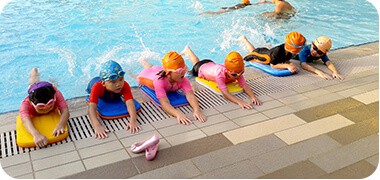
Students will learn how to enter the water safely and how to be safe in deep water. General safety knowledge alongside learning how to move forward and backward in the water is taught as well. Personal survival skills and the ability to properly enter and exit the pool will be covered here. Read more – SwimSafer Stage 1
Intermediate Level
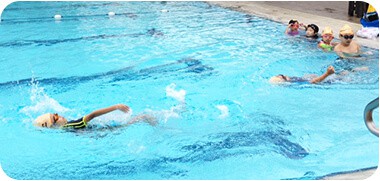
Additional skills on how to get into the water and how to perform a surface dive are covered. Sculling, personal safety skills and awareness of where one is in the water will be introduced as well. Students will learn to swim at least 25 meters. Read more – SwimSafer Stage 2
This stage introduces rescue skills alongside water survival skills. Students will enhance underwater and sculling skills. Handling personal floatation devices will be taught too. During this stage, students will learn how to swim at least 50 meters continuously at this program. Read more – SwimSafer Stage 3
Advance Level
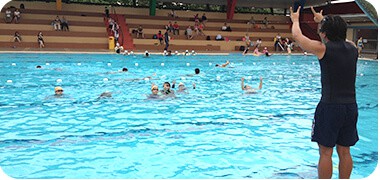
Students will learn how to handle stroke techniques and perform coordinated breathing in deep water. This also works with helping to get children to know how to be safe around water craft and how to work with intermediate water survival and rescue skills. The new goal at this point is to swim for a 100 metres continuously. Read more – SwimSafer Stage 4
This part of the process involves learning how to dive into the water and how to handle advanced rescue and survival skills. A vital part of this process involves allowing the child to learn how to handle swimming strokes so that the child can get to the last stage. Read more – SwimSafer Stage 5
This is the last stage. Students will learn to perform proper swimming strokes in order to swim for 400 metres continuously. Students will learn how to stay afloat with ease for a longer period of time as well. Also, advanced lifesaving rescue, standing dive and safety skills will be continue be taught. Read more – SwimSafer Stage 6
Faq
Yes it is safe. Studies have shown that we are all born with a laryngeal reflex as well as diving response. The diving response will come to play whenever simple submersion are performed. Babies that are submerged one at a time are not exposed to any risk.
There is no need for parents to be in the pool with the child. You can observe the class near the pool.
As they are in different categories, we recommend to conduct the class separately. We will suggest a back to back lesson for your children. We will be using different syllabus for toddler and kid swimming lessons.
It is not advisable to do so. As our kid’s class is design for kids age 5 and above, your child may have difficulty in catching up the pace. It may be counter-productive to do so. We will however, consider the decison on a case by case basis to see if the child is suitable for the class.
You need to have your own swim gear, goggles and float board for the first lesson. Your swimming instructor may advise you further after the first lesson.
Our instructors conducting kids classes are fully qualified with the relevant certifications from the Singapore Sports Council and Singapore Swimming Teachers’ Association. They are trained and experienced in conducting swimming lessons for kids.
You are welcome to register a package that offers a minimum of 12 lessons. You may refer to Kid Swimming Lessons for more information. We are sorry that we do not offer single trial class at the moment.
We highly recommend a doctor’s opinion to be sought first as there are varying degrees of Asthma.
Please email your inquiries to admin@swimclasses.com.sg, we will be in touch with you soon. Alternatively, you can also give us a call at +65 87483645, Mondays-Sundays, 9am-6pm.
Target Audience
This course is suitable for babies of age 6 months to 2 years old, gaining confidence in water, water familiarize themselves, know how to blow bubbles as well as submersion.
Course Outline
Click on the tabs to expand the content.
The way we enter the pool with the baby make a difference in their swimming proficiency and future learning for swimming. Make sure to always remain calm and confident in water. This will reassure the babies and make them feel safe in the water. Every water babies is different and usually requires a different introduction into the water.
Instructor-led | Mode of delivery (Parent Accompanied, Group Discussion, Individual – Directed Learning)
Dipping and swing dips are essential to ensuring the movements in water. You need to have the babies feel secure and not restricted in movements with a hold that firm using minimal support.
Floating comes natural after few dips in the water. This allows newborn babies to have pleasure experiencing water while maintaining close communication with you.
Floating skills teaching is a slow and gentle process for progression.
Floating techniques such as active floating, float swap, walk float, tug float, make float and therapy floating are taught in this phase.
Exercise 1: Safety hold will be taught at this stage. It is a basic holding position to hold the babies to encourage more bodily movements.
Various positions such as rolling to float, arms support floating, chest hold will be taught. This positions will help encourage more kicking in the water.
Exercise 2: Front holding is the second exercise, during this exercise eye contact between babies and parents is crucial to ensure safety and build stronger interaction. A good progression from the previous exercise, it is good point departure for future jumping exercise. It will give them a good alignment for future swimming prone.
Front holding exercise include: front safe holding, bubble blowing, front glide, front surf, swim baby tug
Exercise 3: Holding on to bar and woggle (swim noodle) is the next stage. This stage is the most advanced stage under this section. It encourages the babies to do independent swim without any physical contact.
You will be taught to submerge the babies safely in both relaxed and watchful way.
Submersion exercise will be easier practiced with babies under the age of 4 to 5 months. Any after will become more difficult and should best be put to practices with previous exercises for longer time first.
It will best be practiced with a timing of 2-3 seconds at a time. Each sessions try to limit 2-3 short submersions to get the babies warm up, This exercise will help babies expand their breath holding capacity gradually.
Exercise 3: Babies will be introduced to ducking dives at this stage. This angled dives will build foundation for correct alignment of their bodies in water without straining their necks, and promotes a more efficient and relaxed swimming styles.
Exercise 4: Jumping from the wall and into the pool by the edge is a great confidence booster as well as building block of trust to make the leap forward.
Jumping into the pool
Testimonials
“Thank you Friendly Dolphin Swim School for the informative lessons, good training materials provided. My baby enjoyed the swimming lessons gradually even though they started initially with a lot of tantrums and crying.
– Ricky Low
Tiong Bahru Baby Swimming Lessons
“Very good and interactive! I understood better overall on how to teach and how to make them behave better in water. Enjoyed thoroughly. It helped me know my baby better throughout the whole swimming processes. Instructor was really helpful and willing to share me a lot of tips and making sure the babies are safe in water practices. Great course! Glad I attended.”
– Siew Lin
Tiong Bahru Baby Swimming Lessons
Important message for all parents/students/guardians
- Baby might not be immediately happy in the water and usually need a lot of coaxing, loving focused encouragement without any pressure.
- Children are only allowed into the swimming pool when parents or the instructors say it is safe to do so.
- Make sure children are always in your sight.
- Children should clean up every time after swimming.
- Always keep in mind that the progressions for babies and toddlers are slow. Keep the goals in the long term while enjoying the short and long term benefits of early swimming. The focus here is on mutual enjoyment and create an environment to prepare for future swimming.
- Avoid putting pressure on achievement and embracing quick results. Both of which are counter-productive for all swimming lessons.
- Create pleasurable associations when the babies are exposed to water even if they cry. Be mindful not to display adverse reactions or any negative words when they cry or jump into conclusions that they do not like water.
- Make sure to shower before entering the pool for everyone.
- Be positive, parents who are not confident in water can still help their babies learn to swim; it is a good, positive step!
- Avoid snacking before going into the swimming pool; the snacks can be consumed after swimming.
- Parents have to take close eyes and watch that the babies do not drink too much water during the lessons. Doing this avoids water intoxication and is usually very rare for 30 minutes sessions of different exercises.
DEDICATED COACHES
Fully-trained in house, our professional coaches have undergone strict training and stringent rounds of selections, making them well-equipped in guiding you to feel at ease in teaching your little ones to swim.
CRYSTAL CLEAR WATERS
We are committed to providing a comfortable, controlled environment. Our pools run on excellent salt chlorination, combined with a UV filter, safely eliminating bacteria and other by-products. Enjoy our warm, crystal clear waters without the shivers, stinging eyes, and dry hair and skin!
PROVEN CURRICULUM
Our proven curriculum is developed from 14 years of R & D, together with our parents and children, resulting in a deep understanding of the most effective teaching methods. We now have more than 10,000 students across Singapore and Malaysia, backed by our 200-strong team, nurturing little ripples into big dreams.
